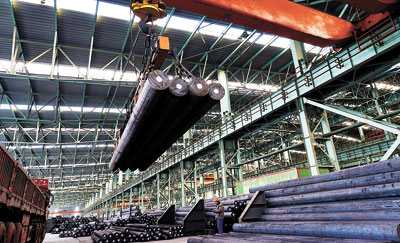|

PLUNGING iron ore prices are providing a lifeline for some of China’s biggest steel mills, but raising the prospect of a rising tide of exports and increased friction with the European Union and countries such as India.
Even as China’s domestic steel demand shrinks and the industry battles chronic overcapacity, lower iron ore prices have helped many large mills post better earnings in 2014 than a year earlier, supported by record exports.
That doesn’t bode well for struggling steelmakers elsewhere in the world, which have been hoping for a shake-out of the industry in China, the world’s top steel producer.
“(Cheaper ore) obviously encourages Chinese steelmakers to still produce because their costs are lower, and because of the overcapacity there’s a strong incentive to still export,” said Jeremy Platt, an analyst at London-based steel consultancy MEPS.
China boosted exports of the alloy by some 50 percent last year to a record 94 million tons, and Western industry bodies see little sign of a major rationalization of the industry.
The latest batch of Chinese steel earnings shows just three of 18 big mills to report so far suffered losses in 2014, down from five the year before. Six of the 13 profit-making mills in 2013 increased profits last year.
“Big Chinese integrated coastal mills are among the most competitive in the world as they have benefited the most from sharp falls in imported iron ore prices, helping them to gain growing market share both at home and abroad,” said Zhao Chaoyue, an analyst with Merchant Futures in Guangzhou.
Seaborne iron ore prices tumbled 50 percent over the course of the year amid a push by mega iron ore miners to ramp up supply and win market share.
Big Chinese mills are able to ship in cheaper seaborne ore direct to their coastal steelmaking operations, selling to customers nearby or shipping steel overseas.
The iron ore price fall also encouraged large mills — those with an annual output of more than 10 million tons — to buy more from the spot market, winning benefits once garnered mainly by more flexible private mills.
Despite the scrapping of tax rebates for exports containing boron that had helped boost sales, Chinese exports rose 41 percent in the first quarter, increasing concerns from rival producers around the world.
South Korea’s POSCO, the world’s sixth-biggest steelmaker, said Tuesday it expected growing pressure from exports from China and Russia, which would hurt prices.
The European Union is imposing anti-dumping duties on imports of cold-rolled flat stainless steel from the Chinese mainland and Taiwan. India’s trade ministry has also recommended anti-dumping duties against China, Malaysia and South Korea for some industrial grade steel imports.
China aims to cut the number of steel mills by more than 40 percent to below 300 by 2017, and plans to have three to five giant steel players by 2025. It wants the top 10 mills to account for 60 percent of output, up from 37 percent of 2014’s production of 823 million tons.
Investors are backing the plan, pushing the shares of some big companies up sharply in 2014, led by Maanshan Iron & Steel whose shares have more than trebled in the past year.
Small mills, however, have been hit by higher environmental costs, tighter credit conditions, and the loss of subsidies and tax breaks once offered by provincial governments eager to keep jobs.
But curbs on overcapacity have yet to take effect, and leading mills are looking to cut costs further by building new coastal plants.
Baoshan Iron & Steel will start production at an integrated coastal plant this year, while Wuhan Iron & Steel is building a similar coastal production base.
Steel mills are looking to win a fresh export rebate, similar to the scrapped boron rebate, by adding chrome to their products, and are targeting emerging regions such as Southeast Asia and South America.
Exports to India doubled last year from 2013, and shipments to the Philippines rose 80 percent.
“China’s move to solve the overcapacity is progressing slowly,” said Bill Chen, a senior trader with Smart Timing Steel, a Hong Kong-based exporter.
(SD-Agencies)
|

